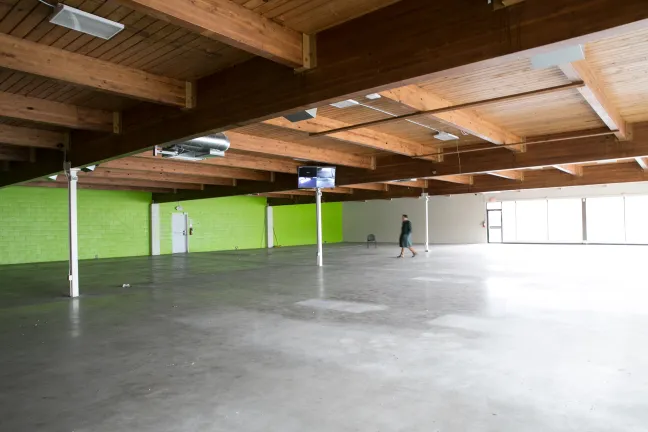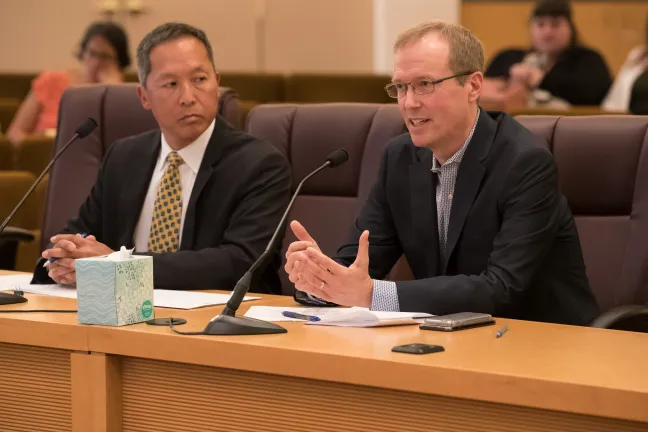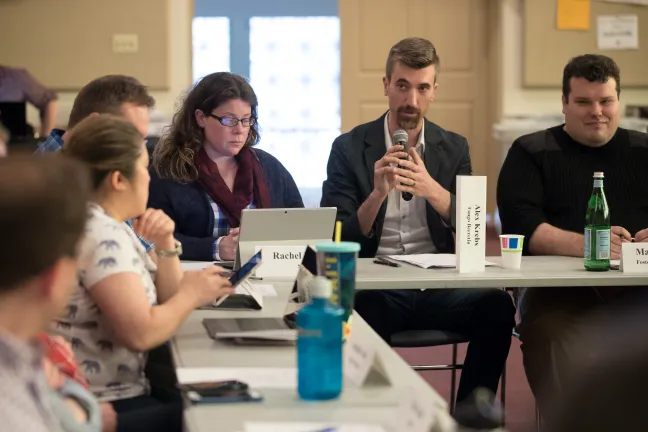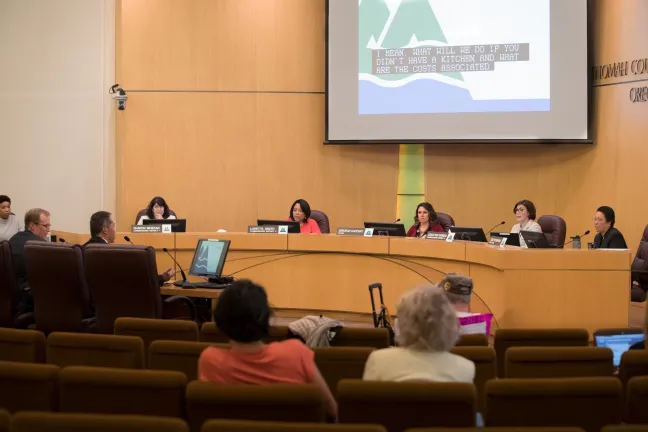The Multnomah County Board of Commissioners voted unanimously Thursday, June 14, to approve a work plan and estimated $3 million construction budget for a planned 120-bed shelter at 6144 SE Foster Road.
Work on the shelter is part of a long-term strategy to shift beds from temporary spaces opened quickly under the city of Portland’s state of emergency to higher-quality, service-rich facilities designed for long-term success.
The shelter will serve women and people in couples, and it will prioritize veterans, people 55 and older and people with disabling conditions. It’s expected to open in early 2019.
Residents at the Foster shelter will have semi-private assigned beds that they’ll keep for as long as they need, with 24-hour access to the site. They’ll also have access to hygiene services (showers, personal care supplies, linens and clothing), locked storage for their belongings, a computer lab, private meeting rooms, an on-site pet relief area, bike parking, and telephones.
The shelter also will connect residents with one-on-one housing and employment case management services. And health and wellness supports will include an on-site health clinic, access to health treatment specialists and peer support services.
“We know that women who are sleeping unsheltered in our community face an enormous risk of physical assault, sexual assault, of being robbed,” said Marc Jolin, director of the Joint Office of Homeless Services. “We know what people with disabilities who are on our streets face an increased risk of being robbed, being assaulted, and having their disabilities further deteriorate. We know that seniors on our streets face the same risks.
“We need to create spaces for them to escape all of those risks,” Jolin continued, “and shelter is one of the strategies to do that. But shelter also has to be the best possible platform for people to move back into permanent housing.”
Questions about cost increases
Thursday’s vote means County facilities staff will embark on the next phase of the shelter’s design and construction process and solicit bids. The renovation is estimated at $3 million for permitting, planning, design and construction costs, and contingencies. Some of that capital funding would come from the City of Portland, through the Joint Office of Homeless Services.
The figure marks an increase from a rough estimate of $2 million provided in January, when the Board voted 4-1 to approve a 10-year lease for the shelter site — a vacant, nearly 14,000-square-foot commercial space — with two five-year options.
“This is an expensive investment,” Chair Deborah Kafoury said. “But it’s a lot more expensive to have people sleeping out on the streets. This is the right thing to do.”
Commissioners asked several questions about the increase in the estimate since January’s presentation and what had caused it.
“This seems like an increase in what we originally thought. Can you line out why the cost has increased?... Could those things not have been foreseen?” asked Commissioner Lori Stegmann, who also made clear the project “is the right thing to do” given the alternative of having to “leave people on the streets.”
Henry Alaman, director of the County’s Facilities & Property Management Division, said some of the change is part of the routine work of refining a design, moving from a project’s conceptual phase to the details needed for a construction bid. He said the design team worked to keep costs from rising higher.
“We want to ensure a quality environment for the people who are living there and to make sure that this shelter integrates well into the community,” Alaman said. “But there have been a lot of robust discussions. ‘Can we live without this? Or do without that?’”
Design plan responds to community feedback
Some of the increase, Alaman and Jolin said, is because of the region’s rising construction costs. Oregon’s construction market has made headlines for high demand, which is driving up prices and leading to labor shortages.
In addition, some costs are connected to city code requirements and the need to build a contingency fund, while others were added in response to feedback from neighbors, advocates and people with lived experience.
Some of the increased costs would help pay for planned upgrades to a recreational courtyard, including landscaping and fencing designed to increase privacy and offer residents a comfortable and attractive place to be outside. They also would pay for additional improvements to the shelter’s sleeping areas and a full-service commercial kitchen so residents could take meals on-site.
Interest in those features surfaced in meetings with community members. Neighbors have been working with Commissioner Jessica Vega Pederson and the Joint Office of Homeless Services to help shape shelter design and operations as part of a public steering committee that has met four times since February. Those committee members are currently working on a Good Neighbor Agreement.
“I appreciate the work that you have done with the steering committee in terms of taking into consideration the desires and the discussion that’s been happening there,” Vega Pederson said. “You mentioned the courtyard. That was very important in terms of the community and the steering committee members wanting to make sure that the courtyard meets the needs of the community living around it and the community living in the shelter.”
“It’s going to be particularly huge”
Commissioner Loretta Smith said she liked the size and footprint of the design plans presented and that she appreciated the services attached. She also noted the most recent “Domicile Unknown” report, which found 88 people died on the community’s streets in 2016. For the “120 people who are going to be served by this, it’s going to be particularly huge.”
But given the size of the construction budget, she joined Commissioner Vega Pederson and Commissioner Stegmann in asking whether it would make more sense for the County to purchase the shelter building or invest in a County-owned building.
“If we could purchase this property, it would make a lot of sense,” Commissioner Smith said. “But to sink in $3 million [in a leased property] is kind of hard for me to navigate.”
Alaman said the County has an option to buy the site, behind neighboring tenant 7-Eleven. But he said the owner wasn’t willing to sell at market price or lower. The County’s consultant on the lease, CBRE, studied that question and said Facilities didn’t have to pursue a sale now but should keep revisiting that question.
Earlier in the presentation, Jolin noted the long road that led to the Foster site and the work to design a shelter that lives up to the County’s values — helping its residents not just stabilize but also work their way back into permanent housing.
The Joint Office’s first step in doubling shelter in Multnomah County was to find temporary spaces or repurpose old government offices, Jolin said. But it’s been more challenging to find the right properties for a long-term, purpose-designed facility.
County and city facilities staff, private brokers, service providers, and even the Portland Business Alliance all worked to identify possible locations. But few of those sites worked.
Some were too small. Some weren’t available. Some needed too much work. Others were also too far from the kinds of amenities that anyone wants and needs in a community, whether in housing or not.
“If you envision a Venn diagram with all of those criteria, at the center of that diagram, there are very few properties remaining,” Jolin said. “Foster was the site that emerged, and I am extremely excited about what Foster presents as an opportunity for folks who would otherwise be sleeping outside.”




